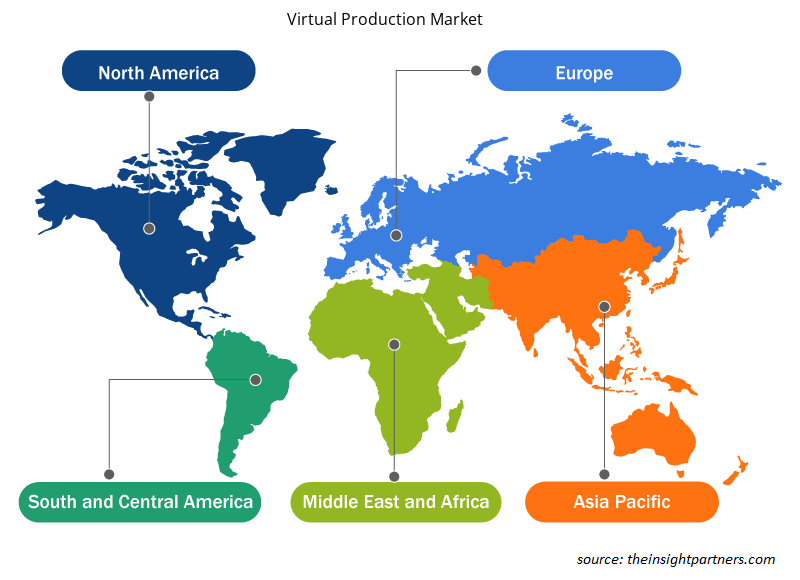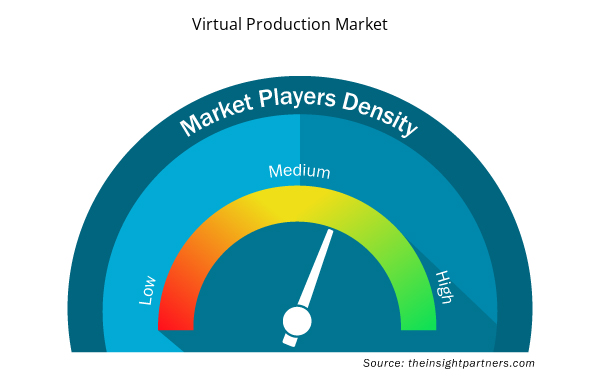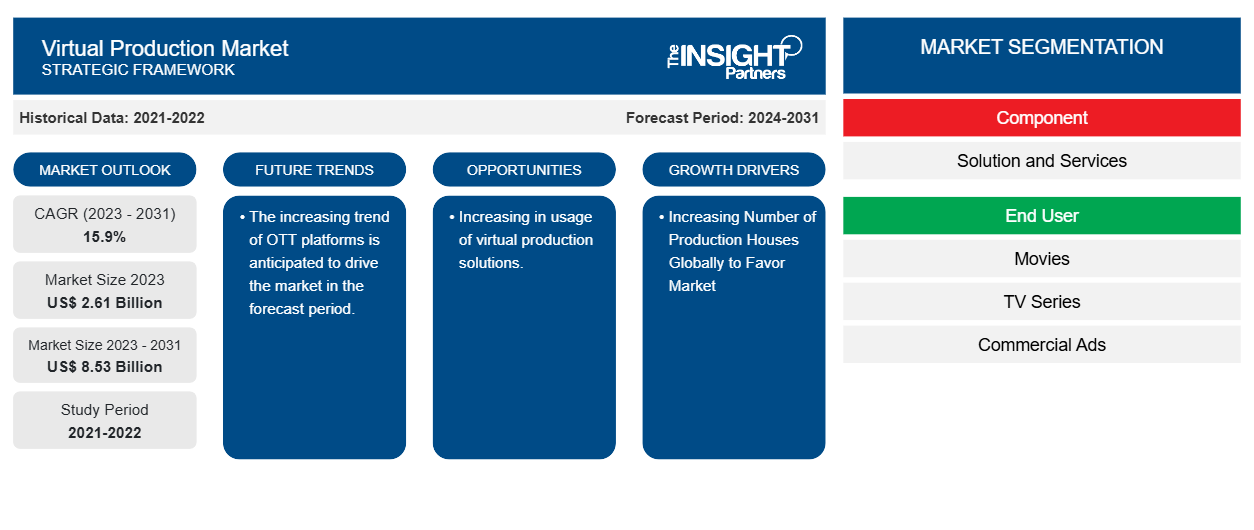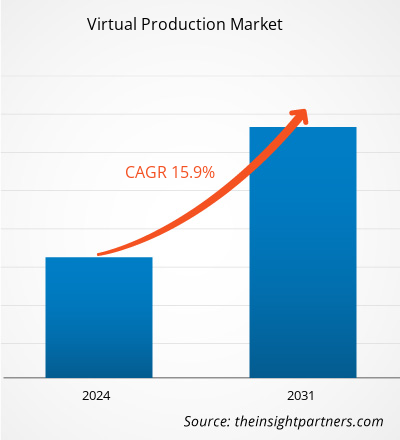Der Markt für virtuelle Produktionen soll von 2,61 Milliarden US-Dollar im Jahr 2023 auf 8,53 Milliarden US-Dollar im Jahr 2031 anwachsen. Der Markt wird zwischen 2023 und 2031 voraussichtlich eine durchschnittliche jährliche Wachstumsrate von 15,9 % verzeichnen. Die steigende Zahl von Produktionshäusern weltweit und die verbesserten Kosten- und Zeiteinsparungen für Produktionshäuser und Inhaltsersteller dürften weiterhin wichtige Trends und Treiber des Marktes bleiben.
Marktanalyse für virtuelle Produktion
Der Markt für virtuelle Produktionen verzeichnet weltweit ein erhebliches Wachstum. Das Wachstum ist auf die steigende Zahl von Produktionshäusern weltweit und die gestiegenen Kosten- und Zeiteinsparungen für Produktionshäuser und Inhaltsersteller zurückzuführen. Darüber hinaus wird erwartet, dass die zunehmende Nutzung virtueller Produktionslösungen und der steigende Trend zu OTT-Plattformen dem Markt für virtuelle Produktion zahlreiche Chancen bieten.
Marktübersicht für virtuelle Produktion
Virtuelle Produktion ist eine Medienproduktionstechnologie, bei der ein virtuelles Set auf großen LED- Wänden hinter einem physischen Set angezeigt wird. Teams verwenden Echtzeit-3D-Engines (Game-Engines), um ein virtuelles Set zu erstellen, es auf der LED-Wand anzuzeigen und die Engines dann mit Kameras am Set zu synchronisieren, um mehr Realismus und perspektivische Tiefe zu erzielen.
Passen Sie diesen Bericht Ihren Anforderungen an
Sie erhalten kostenlos individuelle Anpassungen an jedem Bericht, einschließlich Teilen dieses Berichts oder einer Analyse auf Länderebene, eines Excel-Datenpakets sowie tolle Angebote und Rabatte für Start-ups und Universitäten.
- Holen Sie sich die wichtigsten Markttrends aus diesem Bericht.Dieses KOSTENLOSE Beispiel umfasst eine Datenanalyse von Markttrends bis hin zu Schätzungen und Prognosen.
Treiber und Chancen auf dem Markt für virtuelle Produktion
Steigende Anzahl von Produktionshäusern weltweit begünstigt den Markt
Die steigende Zahl von Produktionsfirmen kann die virtuelle Produktion auf verschiedene Weise vorantreiben. Je mehr Produktionsfirmen gebaut werden, desto mehr steigt die Nachfrage nach effizienten und kostengünstigen Produktionsmethoden. Die virtuelle Produktion ermöglicht es Produktionsfirmen, größer zu bauen, innovativer zu sein und früher im Produktionsprozess qualitativ hochwertige Ergebnisse zu liefern. Darüber hinaus spart die virtuelle Produktion vielen Produktionsfirmen Zeit und Kosten. Durch virtuelles Scouting, bei dem virtuelle Versionen vorgeschlagener Sets erstellt werden, können Reisezeit und zusätzliche Kosten reduziert werden. Durch innovative Entscheidungen zu einem früheren Zeitpunkt im Prozess wird sichergestellt, dass die richtigen Entscheidungen getroffen werden können. Unter Berücksichtigung der oben genannten Parameter treibt die weltweit steigende Zahl von Produktionsfirmen das Wachstum des Marktes für virtuelle Produktion voran.
Zunehmende Nutzung virtueller Produktionslösungen.
Die zunehmende Nutzung virtueller Produktionslösungen dürfte dem Markt für virtuelle Produktionen viele Chancen eröffnen. Verschiedene Branchen implementieren virtuelle Produktionen, was die Nachfrage nach virtuellen Produktionslösungen erhöht. Dies kann neue Akteure und Investitionen anlocken und zu Innovationen und Expansion führen. Darüber hinaus wird virtuelle Produktion nicht nur in den Bereichen Medien und Unterhaltung, sondern auch in der Werbung , bei Live-Events, Spielen und anderen Bereichen eingesetzt. Diese Art der virtuellen Produktion kann neue Umsatz- und Kundenstämme erschließen.
Segmentierungsanalyse des Marktberichts zur virtuellen Produktion
Wichtige Segmente, die zur Ableitung der Marktanalyse zur virtuellen Produktion beigetragen haben, sind Komponenten und Endbenutzer.
- Basierend auf den Komponenten wird der Markt für virtuelle Produktion in Lösungen und Dienstleistungen unterteilt. Das Lösungssegment dürfte im Prognosezeitraum einen erheblichen Marktanteil halten.
- Basierend auf dem Endbenutzer ist der Markt für virtuelle Produktionen in Filme, Fernsehserien, Werbespots und Online-Videos unterteilt. Es wird erwartet, dass der Film im Prognosezeitraum einen erheblichen Marktanteil halten wird.
Virtuelle Produktion – Marktanteilsanalyse nach geografischer Lage
Der geografische Umfang des Marktberichts zur virtuellen Produktion ist hauptsächlich in fünf Regionen unterteilt: Nordamerika, Asien-Pazifik, Europa, Naher Osten und Afrika sowie Süd- und Mittelamerika.
Nordamerika dominiert den Markt für virtuelle Produktion. Der nordamerikanische Markt für virtuelle Produktion ist in die USA, Kanada und Mexiko unterteilt. Außerdem erlebt der Markt ein erhebliches Wachstum. Dieses Wachstum ist auf die steigende Zahl von Produktionshäusern weltweit und die erhöhten Kosten- und Zeiteinsparungen für Produktionshäuser und Inhaltsersteller in der Region zurückzuführen. Darüber hinaus wird erwartet, dass die zunehmende Nutzung virtueller Produktionslösungen und der steigende Trend zu OTT-Plattformen mehrere Chancen für den nordamerikanischen Markt für virtuelle Produktion bieten. Darüber hinaus zwingt eine starke Betonung von Forschung und Entwicklung in den entwickelten Volkswirtschaften der USA und Kanadas die nordamerikanischen Akteure dazu, technologisch fortschrittliche Lösungen auf den Markt zu bringen. Darüber hinaus gibt es in den USA eine große Anzahl von Akteuren auf dem Markt für virtuelle Produktion, die sich zunehmend auf die Entwicklung innovativer Lösungen konzentrieren. All diese Faktoren tragen zum Wachstum des Marktes für virtuelle Produktion in der Region bei.
Virtuelle Produktion
Regionale Einblicke in den Markt für virtuelle Produktion
Die regionalen Trends und Faktoren, die den Markt für virtuelle Produktion im gesamten Prognosezeitraum beeinflussen, wurden von den Analysten von Insight Partners ausführlich erläutert. In diesem Abschnitt werden auch Marktsegmente und Geografien für virtuelle Produktion in Nordamerika, Europa, im asiatisch-pazifischen Raum, im Nahen Osten und Afrika sowie in Süd- und Mittelamerika erörtert.

- Holen Sie sich regionale Daten zum Markt für virtuelle Produktion
Umfang des Marktberichts zur virtuellen Produktion
| Berichtsattribut | Details |
|---|---|
| Marktgröße im Jahr 2023 | 2,61 Milliarden US-Dollar |
| Marktgröße bis 2031 | 8,53 Milliarden US-Dollar |
| Globale CAGR (2023 - 2031) | 15,9 % |
| Historische Daten | 2021-2022 |
| Prognosezeitraum | 2024–2031 |
| Abgedeckte Segmente | Nach Komponente
|
| Abgedeckte Regionen und Länder | Nordamerika
|
| Marktführer und wichtige Unternehmensprofile |
|
Dichte der Marktteilnehmer für virtuelle Produktion: Deren Auswirkungen auf die Geschäftsdynamik verstehen
Der Markt für virtuelle Produktion wächst rasant, angetrieben durch die steigende Nachfrage der Endnutzer aufgrund von Faktoren wie sich entwickelnden Verbraucherpräferenzen, technologischen Fortschritten und einem größeren Bewusstsein für die Vorteile des Produkts. Mit steigender Nachfrage erweitern Unternehmen ihr Angebot, entwickeln Innovationen, um die Bedürfnisse der Verbraucher zu erfüllen, und nutzen neue Trends, was das Marktwachstum weiter ankurbelt.
Die Marktteilnehmerdichte bezieht sich auf die Verteilung der Firmen oder Unternehmen, die in einem bestimmten Markt oder einer bestimmten Branche tätig sind. Sie gibt an, wie viele Wettbewerber (Marktteilnehmer) in einem bestimmten Marktraum im Verhältnis zu seiner Größe oder seinem gesamten Marktwert präsent sind.
Die wichtigsten auf dem Markt für virtuelle Produktion tätigen Unternehmen sind:
- 360Rize
- INSTA 360
- Boris FX
- Epische Spiele; Inc
- Brompton Technology GmbH
- Adobe Inc.
Haftungsausschluss : Die oben aufgeführten Unternehmen sind nicht in einer bestimmten Reihenfolge aufgeführt.

- Überblick über die wichtigsten Akteure auf dem Markt für virtuelle Produktion
Neuigkeiten und aktuelle Entwicklungen zum Markt der virtuellen Produktion
Der Markt für virtuelle Produktion wird durch die Erhebung qualitativer und quantitativer Daten nach Primär- und Sekundärforschung bewertet, die wichtige Unternehmensveröffentlichungen, Verbandsdaten und Datenbanken umfasst. Nachfolgend sind einige der Entwicklungen auf dem Markt für virtuelle Produktion aufgeführt:
- Dimension hat die Einführung von DNEG 360 angekündigt, das Dimension‘s Expertise in der Echtzeitproduktion mit DNEG‘s weltweit führenden visuellen Unterhaltungsdiensten kombiniert. Parallel zur Einführung von DNEG 360 hat das Unternehmen einen exklusiven Blick hinter die Kulissen veröffentlicht: „Die Evolution der virtuellen Produktion“, um seine fortschrittlichen Techniken und Fortschritte bei der virtuellen Produktion vorzustellen. (Quelle: Dimension Company Website, April 2024)
- Die Vancouver Film School hat sich mit Pixomondo (PXO) zusammengetan, um VFS-Studenten ein neues Angebot zu unterbreiten. Virtual Art Department Content Creation ist ein 12-wöchiges Zertifikatsprogramm, das von Pixomondo entwickelt wurde, um Kreativen die Grundlagen der Inhaltserstellung für die virtuelle Produktion in VFX beizubringen. (Quelle: Pixomondo (PXO) Unternehmenswebsite, April 2024)
Marktbericht zur virtuellen Produktion – Abdeckung und Ergebnisse
Der Bericht „Marktgröße und Prognose für virtuelle Produktion (2021–2031)“ bietet eine detaillierte Analyse des Marktes, die die folgenden Bereiche abdeckt:
- Größe und Prognose des Marktes für virtuelle Produktion auf globaler, regionaler und Länderebene für alle abgedeckten wichtigen Marktsegmente.
- Markttrends sowie Marktdynamiken im Bereich virtuelle Produktion wie treibende Kräfte, Hemmnisse und wichtige Chancen.
- Detaillierte PEST/Porters Five Forces- und SWOT-Analyse.
- Analyse des Marktes für virtuelle Produktion, die wichtige Markttrends, globale und regionale Rahmenbedingungen, wichtige Akteure, Vorschriften und aktuelle Marktentwicklungen umfasst.
- Branchenlandschaft und Wettbewerbsanalyse, einschließlich Marktkonzentration, Heatmap-Analyse, prominenten Akteuren und aktuellen Entwicklungen für den Markt der virtuellen Produktion.
- Detaillierte Firmenprofile.
- Historische Analyse (2 Jahre), Basisjahr, Prognose (7 Jahre) mit CAGR
- PEST- und SWOT-Analyse
- Marktgröße Wert/Volumen – Global, Regional, Land
- Branche und Wettbewerbsumfeld
- Excel-Datensatz


- Maritime Analytics Market
- Electronic Toll Collection System Market
- Predictive Maintenance Market
- Animal Genetics Market
- Cosmetic Bioactive Ingredients Market
- HVAC Sensors Market
- Medical and Research Grade Collagen Market
- Fish Protein Hydrolysate Market
- Intraoperative Neuromonitoring Market
- Real-Time Location Systems Market

Report Coverage
Revenue forecast, Company Analysis, Industry landscape, Growth factors, and Trends

Segment Covered
This text is related
to segments covered.

Regional Scope
North America, Europe, Asia Pacific, Middle East & Africa, South & Central America

Country Scope
This text is related
to country scope.
Häufig gestellte Fragen
North America is anticipated to dominate the virtual production market in 2023.
The increasing number of production houses globally and enhanced cost and time savings for production houses and content creators are some of the factors driving the virtual production market.
The increasing trend of OTT platforms is anticipated to drive the market in the forecast period.
The key players holding majority shares in the global virtual production market are 360Rize, INSTA 360, Boris FX, Epic Games Inc, Brompton Technology Ltd, Adobe Inc., Autodesk, Inc, WIDIA Corporation, HTC Corporation (VIVE), MO-SYS ENGINEERING LTD.
The global virtual production market is expected to reach US$ 8.53 billion by 2031.
The expected CAGR of the virtual production market is 15.9%.
Trends and growth analysis reports related to Technology, Media and Telecommunications : READ MORE..
The Insight Partners performs research in 4 major stages: Data Collection & Secondary Research, Primary Research, Data Analysis and Data Triangulation & Final Review.
- Data Collection and Secondary Research:
As a market research and consulting firm operating from a decade, we have published and advised several client across the globe. First step for any study will start with an assessment of currently available data and insights from existing reports. Further, historical and current market information is collected from Investor Presentations, Annual Reports, SEC Filings, etc., and other information related to company’s performance and market positioning are gathered from Paid Databases (Factiva, Hoovers, and Reuters) and various other publications available in public domain.
Several associations trade associates, technical forums, institutes, societies and organization are accessed to gain technical as well as market related insights through their publications such as research papers, blogs and press releases related to the studies are referred to get cues about the market. Further, white papers, journals, magazines, and other news articles published in last 3 years are scrutinized and analyzed to understand the current market trends.
- Primary Research:
The primarily interview analysis comprise of data obtained from industry participants interview and answers to survey questions gathered by in-house primary team.
For primary research, interviews are conducted with industry experts/CEOs/Marketing Managers/VPs/Subject Matter Experts from both demand and supply side to get a 360-degree view of the market. The primary team conducts several interviews based on the complexity of the markets to understand the various market trends and dynamics which makes research more credible and precise.
A typical research interview fulfils the following functions:
- Provides first-hand information on the market size, market trends, growth trends, competitive landscape, and outlook
- Validates and strengthens in-house secondary research findings
- Develops the analysis team’s expertise and market understanding
Primary research involves email interactions and telephone interviews for each market, category, segment, and sub-segment across geographies. The participants who typically take part in such a process include, but are not limited to:
- Industry participants: VPs, business development managers, market intelligence managers and national sales managers
- Outside experts: Valuation experts, research analysts and key opinion leaders specializing in the electronics and semiconductor industry.
Below is the breakup of our primary respondents by company, designation, and region:

Once we receive the confirmation from primary research sources or primary respondents, we finalize the base year market estimation and forecast the data as per the macroeconomic and microeconomic factors assessed during data collection.
- Data Analysis:
Once data is validated through both secondary as well as primary respondents, we finalize the market estimations by hypothesis formulation and factor analysis at regional and country level.
- Macro-Economic Factor Analysis:
We analyse macroeconomic indicators such the gross domestic product (GDP), increase in the demand for goods and services across industries, technological advancement, regional economic growth, governmental policies, the influence of COVID-19, PEST analysis, and other aspects. This analysis aids in setting benchmarks for various nations/regions and approximating market splits. Additionally, the general trend of the aforementioned components aid in determining the market's development possibilities.
- Country Level Data:
Various factors that are especially aligned to the country are taken into account to determine the market size for a certain area and country, including the presence of vendors, such as headquarters and offices, the country's GDP, demand patterns, and industry growth. To comprehend the market dynamics for the nation, a number of growth variables, inhibitors, application areas, and current market trends are researched. The aforementioned elements aid in determining the country's overall market's growth potential.
- Company Profile:
The “Table of Contents” is formulated by listing and analyzing more than 25 - 30 companies operating in the market ecosystem across geographies. However, we profile only 10 companies as a standard practice in our syndicate reports. These 10 companies comprise leading, emerging, and regional players. Nonetheless, our analysis is not restricted to the 10 listed companies, we also analyze other companies present in the market to develop a holistic view and understand the prevailing trends. The “Company Profiles” section in the report covers key facts, business description, products & services, financial information, SWOT analysis, and key developments. The financial information presented is extracted from the annual reports and official documents of the publicly listed companies. Upon collecting the information for the sections of respective companies, we verify them via various primary sources and then compile the data in respective company profiles. The company level information helps us in deriving the base number as well as in forecasting the market size.
- Developing Base Number:
Aggregation of sales statistics (2020-2022) and macro-economic factor, and other secondary and primary research insights are utilized to arrive at base number and related market shares for 2022. The data gaps are identified in this step and relevant market data is analyzed, collected from paid primary interviews or databases. On finalizing the base year market size, forecasts are developed on the basis of macro-economic, industry and market growth factors and company level analysis.
- Data Triangulation and Final Review:
The market findings and base year market size calculations are validated from supply as well as demand side. Demand side validations are based on macro-economic factor analysis and benchmarks for respective regions and countries. In case of supply side validations, revenues of major companies are estimated (in case not available) based on industry benchmark, approximate number of employees, product portfolio, and primary interviews revenues are gathered. Further revenue from target product/service segment is assessed to avoid overshooting of market statistics. In case of heavy deviations between supply and demand side values, all thes steps are repeated to achieve synchronization.
We follow an iterative model, wherein we share our research findings with Subject Matter Experts (SME’s) and Key Opinion Leaders (KOLs) until consensus view of the market is not formulated – this model negates any drastic deviation in the opinions of experts. Only validated and universally acceptable research findings are quoted in our reports.
We have important check points that we use to validate our research findings – which we call – data triangulation, where we validate the information, we generate from secondary sources with primary interviews and then we re-validate with our internal data bases and Subject matter experts. This comprehensive model enables us to deliver high quality, reliable data in shortest possible time.


 Holen Sie sich ein kostenloses Muster für diesen Bericht
Holen Sie sich ein kostenloses Muster für diesen Bericht